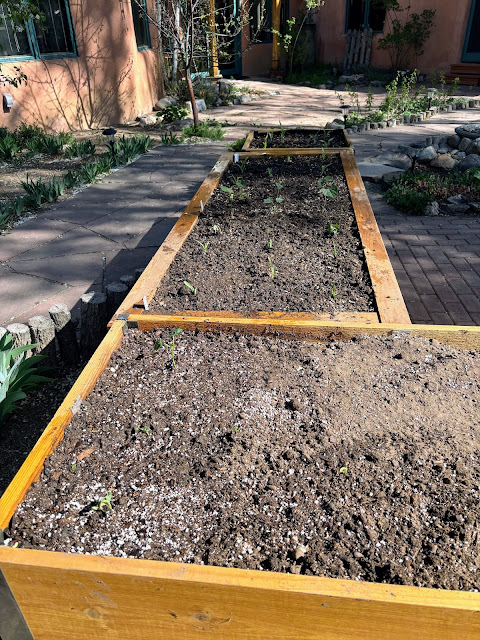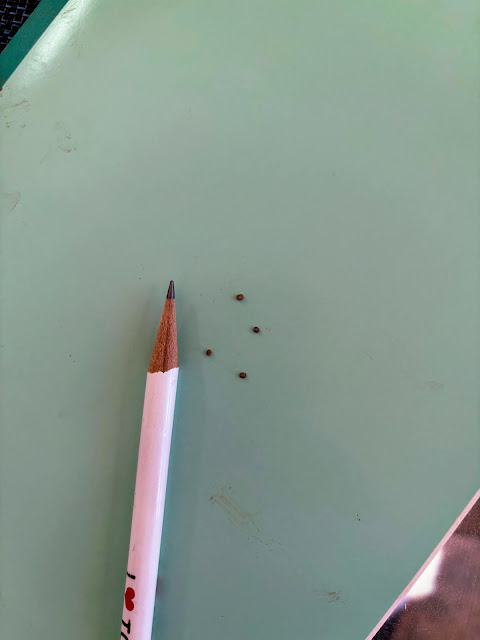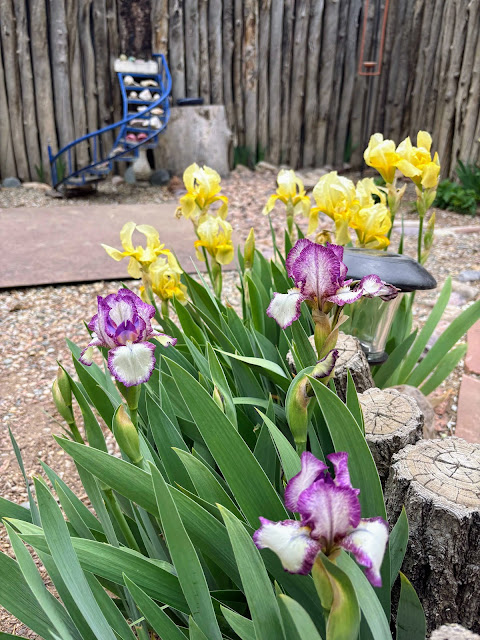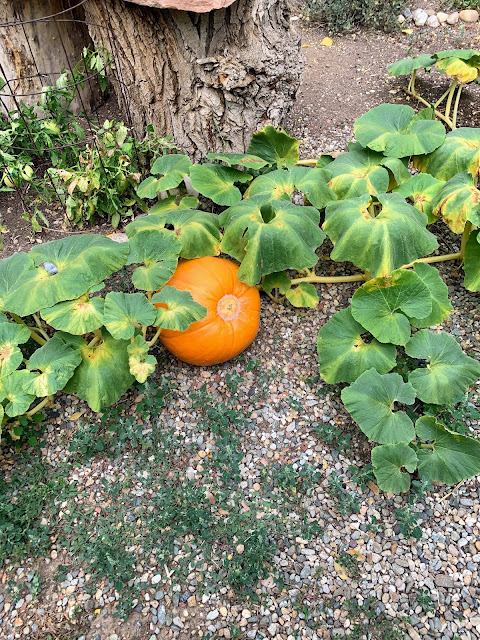For a few years, I have been attempting vegetable gardening. I enjoy being outside in our quarter-acre plot. My husband cares for the flowers and I try to grow vegetables and herbs.
The second year, I managed a few potatoes and a full vine of cherry tomatoes, which were delicious. Then came a couple years with beautiful peas and beans ... until grasshoppers ate the delicate sprouts.
Last year’s effort to grow the indigenous “three sisters” – corn, beans and squash planted near each other – was a failure, mainly for lack of adequate sun.
This year, our neighbor allowed us to trim some of the Siberian elm trees that form the border between his place and ours. More on these pernicious trees later. Having more sun should make a difference. I also bought some raised boxes and so far, the blue corn from Taos Pueblo and some black Aztec corn are doing well alongside pole beans.
 |
| Corn and beans in raised bed |
At the suggestion of the local “extension service”, I added arugula seeds to provide ground cover to the corn and beans during the hot summer months,
 |
| Arugula seeds |
Arugula seeds are the size of poppy seeds – pretty darn tiny to try to plant in groups of three!]
Why, you might ask, is it so difficult to grow a few vegetables? After all, the San Luis Valley which follows the Rio Grande south from Colorado into northern New Mexico, produces plenty of fruits and vegetables for local and even out-of-state markets.
 |
| 4 RG River, Juan Bautista Rael1951 from NM.Gov |
But Taos is at 6,969 feet (2,124 m) above sea level, the air is dry and the earth is largely dense clay. Just north of Taos is Wheeler Peak, at 4,011 m, the highest point in New Mexico.
Increasingly, water is a problem, too. With decreased snow pack each year compounded by the sale of New Mexico’s river water to the oil industry for their use in fracking for oil – making New Mexico the second largest producer of oil in the US, after Texas – farmers face stricter limits on the use of water. So far, the town of Taos has put no restrictions on the use of water.
And those Siberian elm trees, ugh. They are an invasive tree, brought to the US because they were resistant to Dutch elm disease and to provide shade. But they are prolific in their reproduction, maybe the rabbit of the tree kingdom? And their root systems are deep, allowing them to search far and wide for available moisture. The roots are EVERYWHERE in our neighborhood. In fact, a friend down the street has spent hot, dirty hours digging up roots to clear a patch for his vegetables!
To add yet another glitch to this year’s challenges, we have a skunk living under a deck. We had to stop letting our dog out for a pee in the middle of the night because she got skunked twice. Yes, “to be skunked” is a term around here. We bowed to the inevitable and bought a skunk cage which uses the most foul-smelling bait I have ever experienced.
 |
| Skunk trap |
 |
Tindy with a drippy eye after being skunked
|
So far, the skunk is resisting the lure of marshmallows covered in black goo. If we catch him (or her), we will take him to a place near-by that is well known for being hospitable to displaced skunks.
 |
| Irises |
 |
| Homage to Ukraine |
But ... the flowers are doing well despite me being their major caregiver this year.
Working in the garden and spending time with a fun-loving dog provide healthy respites from the stresses of leading and participating in rallies and other resistance to the current US administration.
 |
| Watering my baby corn and bean plants |
 |
| Tindy exhausted from another de-stuffing |
Almost every day, I re-stuff one or more stuffed animals after Tindy de-stuffs them. Destruction, re-construction and repair. I guess that’s part of the cycle of life.
A few of you seem to have more success with food gardening than I do. Any tips for high altitude, rocky and clay-ey soil and scarce water?
Paula Claycomb, Retired from UNICEF in 2013 and worked with Rain Barrel Communications until 2024.










Comments
Post a Comment
If you are a member of XUNICEF, you can comment directly on a post. Or, send your comments to us at xunicef.news.views@gmail.com and we will publish them for you.